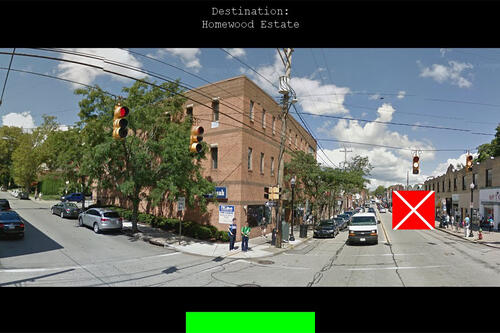
Google Street View navigation experience used in the study (Image provided)
Author
Additional Authors and Editors
Publication
Journal of Neuroscience (2024)
Article title:
"Stereotypical hippocampal clustering predicts navigational success in virtualized real-world environments"
Summary:
People who excel at navigating new environments share a similar, optimal way their brains organize memory and direction-sensing, hinting at a potential universal blueprint for spatial learning success.
Abstract:
Structural differences along the hippocampal long-axis have long been believed to underlie meaningful functional differences. Recent findings show that data-driven parcellations of the hippocampus sub-divide the hippocampus into a 10-cluster map with anterior-medial, anterior-lateral, and posteroanterior-lateral, middle, and posterior components. We tested whether task and experience could modulate this clustering using a spatial learning experiment where male and female participants were trained to virtually navigate a novel neighborhood in a Google Street View-like environment. Participants were scanned while navigating routes early in training and at the end of a two-week training period. Using the 10-cluster map as the ideal template, we find that participants who eventually learn the neighborhood well have hippocampal cluster-maps consistent with the ideal—even on their second day of learning—and their cluster mappings do not deviate over the two week training period. However, participants who eventually learn the neighborhood poorly begin with hippocampal cluster-maps inconsistent with the ideal template, though their cluster mappings may become more stereotypical after the two week training. Interestingly this improvement seems to be route-specific: after some early improvement, when a new route is navigated, participants’ hippocampal maps revert back to less stereotypical organization. We conclude that hippocampal clustering is not dependent solely on anatomical structure, and instead is driven by a combination of anatomy, task, and importantly, experience. Nonetheless, while hippocampal clustering can change with experience, efficient navigation depends on functional hippocampal activity clustering in a stereotypical manner, highlighting optimal divisions of processing along the hippocampal anterior-posterior and medial-lateral-axes.
Primary research questions:
The hippocampus (an area that is key to spatial memory) organizes into 10 distinct clusters (the mICA-10 map) while at rest, we wanted to know what this map means.
1. Does the hippocampus stay organized in the mICA-10 configuration during a task that uses the hippocampus (like spatial navigation)?
2. Does the organization of the hippocampus change as someone learns a new spatial environment? (i.e., does the organization look different in a new environment and does it change as someone learns that environment?)
3. Does spatial navigation ability or performance affect the hippocampus' organization? (i.e., do people who learn environments easily show different hippocampal organization maps compared to those who are poorer spatial learners?)
What the research builds on:
The hippocampus organizes into 10 distinct clusters while at rest. The hippocampus is heavily involved in both spatial learning and spatial navigation. Its precise organization and how it might change during spatial navigation and spatial learning however were unknown.
What the research adds to the discussion:
We have documented the organization of the hippocampus during a spatial learning task, and specifically shown how experience and ability influence its organization. Specifically, the hippocampus organizes into the mICA-10 map for strong spatial learners in both new and practiced environments. For weaker spatial learners, their hippocampi are not clearly organized into the mICA-10 map in new environments, but as they gain experience with those new environments such that they become practiced environments, the hippocampal organization changes to become more mICA-10-like.
Novel methodology:
We used masked independent component analysis (mICA) to find clusters of functional activity in the hippocampus. Essentially, this involves looking at the neural activity in the hippocampus, and finding regions that seem to be processing separate kinds of information than others. This approach was not our invention but it has been sparsely used. Previous approaches to segmenting the hippocampus involve looking at its anatomy and determining clusters based on anatomical borders, under the assumption that different processing is occurring in different anatomical regions. Our approach is more data-driven and looks directly at the functional activity to find clusters of common activity, rather than assuming anatomical borders divide activity.
Implications for society:
Our work helps us understand why some individuals may be better or worse at learning spatial environments, and suggests that individuals who are worse may be so because their natural brain organization is suboptimal. However our work also shows that with experience those individuals can re-organize into more optimal organizations. This work helps us understand how optimal brain organization may be critical for learning in many domains, and how one underlying task with learning may be to learn how to organize our brains in more ideal ways, for whatever task is at hand.
Implications for research:
This work provides a basis for future research in spatial memory. The mICA-10 approach we present can be used in future research to further use functional activity to map brain organization, rather than depend on anatomical segregation to guess at border of functional activity. Also, future research which could identify other optimal organizational maps of the hippocampus in other tasks (assuming there are other optimal organizational maps in other conditions) might shed light on the dynamic ways in which our brains can re-organize to tackle different problems.
Funding:
NIH grant 1R15NS104979-01
Citation:
Jason D. Ozubko, Madelyn Campbell, Abigail Verhayden, Brooke Demetri, Molly Brady, John Thorp, and Iva Brunec, "Stereotypical hippocampal clustering predicts navigational success in virtualized real-world environments," Journal of Neuroscience, 19 April 2024, e1057232024